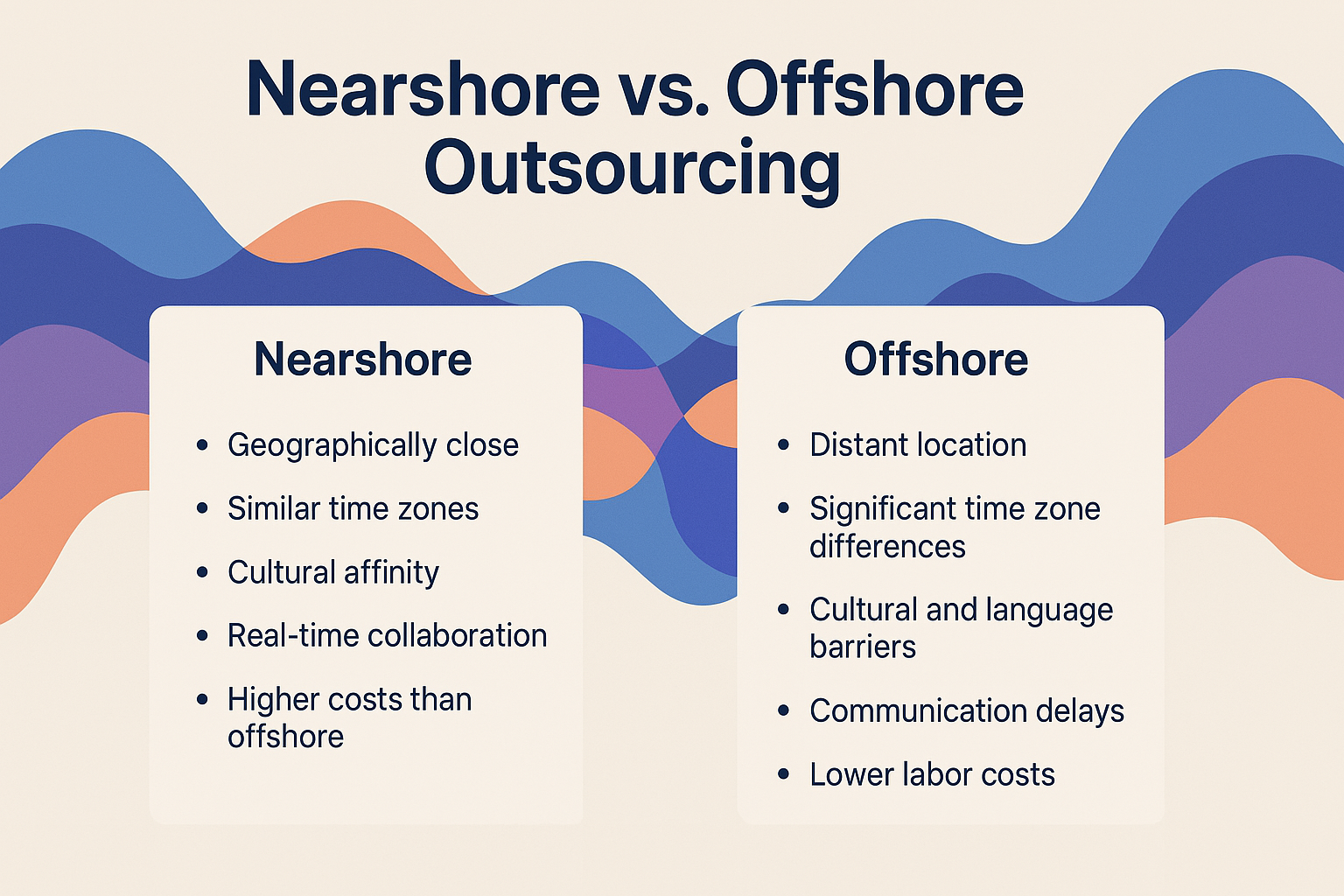IT leaders are constantly challenged to deliver projects faster and bridge skill gaps amid tight budgets and talent shortages. This is where outsourcing and staff augmentation come into play. By leveraging external teams or specialists, companies can scale their IT capabilities on-demand. In fact, a global shortage of software engineers (estimated to reach 85 million by 2030) is driving organizations to tap into worldwide talent pools. Outsourcing allows businesses to lower costs, speed up development, and focus on core competencies.
More importantly, IT staff augmentation – hiring external tech experts to extend your in-house team – offers flexibility to get critical skills quickly without long-term hiring commitments. With the rise of remote work (94% of employers report productivity stayed the same or improved with remote teams), CTOs and CIOs are increasingly comfortable collaborating with talent beyond their office walls. The key question becomes: Nearshore or Offshore? This article will compare nearshore vs offshore outsourcing models for IT staff augmentation, examining cost, talent, culture, speed, and risk factors to help tech leaders choose the right approach.
Definitions: Nearshore vs. Offshore Outsourcing in IT Staffing
When we talk about nearshore vs offshore outsourcing, we’re referring to the geographic location and time zone of your external IT team:
- Offshore outsourcing generally means contracting work to a far-away country, typically overseas in a distant time zone. For example, a U.S. company offshoring might work with teams in India or Eastern Europe. Offshoring often aims to exploit lower labor costs in those regions. In formal terms, “Offshoring [is] relocating work or services to third-party providers overseas.”. This model can provide access to vast talent pools worldwide, but usually comes with differences in working hours and cultural context.
- Nearshore outsourcing means outsourcing to a nearby country, usually one that is geographically close and in a similar time zone. For a U.S. firm, nearshoring might involve working with teams in Latin America; for a Western European company, nearshoring could mean Eastern Europe. According to TechTarget, “nearshore outsourcing is the practice of getting work done by people in neighboring countries” as opposed to far-off regions. The idea is to combine proximity and cultural alignment with many of the cost benefits of offshoring. Nearshore partners often share more linguistic or cultural similarities and have workday overlap with your team.
- IT Staff Augmentation is an outsourcing strategy where you hire external IT specialists to augment (extend) your in-house team on a temporary or project basis. Instead of fully handing off a project, you’re integrating outside engineers, developers, or designers who work under your direction alongside your staff. Both nearshore and offshore vendors offer staff augmentation services – the difference lies in where those augmented staff are located (nearby vs. far).
In summary, nearshore and offshore are location-based outsourcing models, and staff augmentation is a hiring model that can leverage either nearshore or offshore talent. A nearshore staff augmentation partner will embed team members from a nearby country into your organization, whereas offshore staff augmentation might add remote team members from across the globe. The choice between them impacts everything from cost to communication, as we’ll explore next.
Comparing Nearshore and Offshore Outsourcing: Key Factors
When deciding between nearshore and offshore models for IT staff augmentation, CTOs and tech managers should weigh several important factors. Here we break down how the two models stack up in terms of cost, talent, cultural alignment, onboarding speed, and risk.
Cost-Effectiveness
Cost is often the primary driver for outsourcing decisions. Offshore outsourcing traditionally offers the lowest hourly rates – countries like India or Vietnam, for example, have significantly lower salary scales than the US or Western Europe. This can translate into substantial savings. However, nearshore outsourcing also delivers major cost benefits while avoiding some hidden expenses. Studies show that companies use nearshore engagements largely as a cost-cutting tool: in fact, 87% of IT businesses surveyed considered nearshore outsourcing specifically to reduce costs during economically tight times. A Deloitte analysis found 59% of companies choose nearshore development to cut costs.
Nearshore developers’ rates can be 20-50% lower than local onshore staff depending on the region. For instance, one report noted that nearshore software development rates are about 46% lower than onshore rates on average. Offshore rates in regions like South Asia might be even lower on the surface, especially for commodity skills. But offshore’s ultra-low rates may come with trade-offs – potential inefficiencies, higher management overhead, or quality issues that can eat into the savings. As one industry source points out, while offshoring can be cheaper at the low end of skill requirements, “there is almost no difference [in cost] on the high end” once you factor in the need for highly skilled talent and coordination efforts.
Moreover, nearshoring can reduce ancillary costs that offshoring incurs, such as expensive long-distance travel for occasional face-to-face meetings, or the productivity loss from miscommunication and overnight delays. By working in closer time zones with better alignment, nearshore teams often get work done faster, which is another form of cost efficiency. In one case, a U.S. tech company saved roughly 30% in operational costs by outsourcing development to a nearshore partner in Mexico – achieving cost savings while still collaborating in real-time. In short, offshore may maximize rate arbitrage, but nearshore often optimizes total cost-effectiveness when you consider efficiency and speed. Many CIOs view nearshore outsourcing as the “best of both worlds” – significant savings with fewer headaches.
Talent Availability and Quality
Another critical factor is access to the right skills and talent pool. Offshore outsourcing opened up the entire world’s talent to companies – one reason it became so popular in the early 2000s. Nations like India churn out large numbers of IT graduates and have mature outsourcing industries, meaning an offshore vendor can often source a broad range of skills quickly. If you need 50 Java developers or a team of SAP consultants, an offshore provider might have a bench of candidates ready. However, nearshore regions have rapidly grown their tech talent pools in recent years. Latin America, for example, is emerging as a hotspot for software engineers serving the North American market, while Eastern European countries like Poland and Ukraine (often nearshore for Western Europe) produce top-tier developers.
One industry trend is that more companies are looking nearshore for specialized talent. A recent survey noted that 80% of North American companies are actively considering nearshore outsourcing options. Even small businesses are jumping on board – 21% of small businesses outsourcing in 2021 said they planned to hire a nearshore firm, up from 15% the year prior. This growth indicates that nearshore regions are supplying talent that businesses need, whether due to high English proficiency, specific technical expertise (like blockchain or AI skills in certain hubs), or simply greater availability compared to tight local labor markets. In the U.S. and Europe, the tech unemployment rate remains very low, making it tough to hire locally. Staff augmentation through outsourcing is a vital relief valve.
In terms of quality, both nearshore and offshore providers can offer excellent engineers – but vetting is key. Offshoring sometimes got a reputation for variable quality or high turnover, though top offshore firms certainly deliver great results. Nearshore providers often highlight having more culturally aligned education and work standards, which can translate to faster ramp-up and understanding of project needs. For example, U.S. companies often find that developers in Latin America have a similar approach to agile development as their in-house teams, making integration smoother. Ultimately, the best approach is to choose a partner (nearshore or offshore) with a proven talent screening process and domain expertise in the skills you require. The good news: wherever they are located, outsourced staff augmentation can grant you virtually unlimited reach to find the exact expertise you need – a critical advantage when the global IT skills shortage threatens to hit $8.4 trillion in lost revenues by 2030 if positions go unfilled.
Cultural and Time Zone Alignment
One of the biggest distinguishing factors of nearshore vs. offshore is cultural and time zone alignment. Nearshore outsourcing shines in this area. Because nearshore teams are in nearby or neighboring regions, they typically share more of your working hours and often have closer cultural ties. This can greatly improve day-to-day collaboration. There’s less risk of your 9 AM status meeting falling at midnight for your developers. Teams can resolve issues in real-time rather than waiting 24 hours to hear back from an offshore counterpart. According to industry surveys, this alignment pays off in performance – 78% of companies using nearshore outsourcing reported higher customer satisfaction due to improved service quality and faster response times. Essentially, working with a team that’s awake and online when you are leads to quicker answers and more agile problem-solving.
Cultural alignment is also a soft but important factor. Nearshore teams often have strong language skills and familiar business practices. For instance, many Latin American tech professionals are fluent in English and well-versed in Western business culture, making them an easy fit for U.S. companies. Eastern European engineers working with UK or German firms similarly tend to integrate with less friction. “US-based companies seek nearshore talent because of close workday overlap, strong cultural fit, and high English proficiency,” as one Accelerance report notes. This comfort level can boost productivity and trust. A nearshore developer who understands your idioms, holidays, and expectations can feel like an extension of your in-house team rather than a vendor.
Offshore arrangements, by contrast, often involve wide time zone gaps and more pronounced cultural differences. It’s certainly possible to overcome these – companies have successfully managed offshore teams for decades – but it requires deliberate effort. Late-night or early-morning calls become routine. Miscommunications are more likely when there are language barriers or differing norms in giving feedback or raising issues. As one nearshoring firm quipped, “Who wants to be on work calls at 11 PM? Who wants to wait a day for an answer to a quick question?”. These pain points are real in some offshore relationships, especially when real-time collaboration is needed (for example, in agile sprints or DevOps workflows). Cultural mismatches can also lead to misunderstandings in requirements or quality standards. A simple example: what it means to “deliver by end of day” might differ across cultures and time zones.
None of this is to say offshore teams cannot align or that all nearshore engagements are seamless – but the inherent advantage of nearshore is proximity. Being closer in geography and culture acts as a lubricant for teamwork. It’s no surprise that physical proximity now ranks as the #1 factor in choosing an IT outsourcing provider for many organizations. Leaders have seen that having a team next door (figuratively speaking) makes a difference. If your project demands tight collaboration, frequent meetings, or deep integration with your in-house staff, a nearshore staff augmentation model will likely reduce friction and yield better outcomes on this front.
Infographic comparing nearshoring vs. offshoring. Nearshore outsourcing offers proximity (same/similar time zones, easier travel), cultural affinity and real-time communication, whereas offshoring often involves delays (12–24 hour time lags) and greater coordination challenges.
Speed of Onboarding
When a new project is green-lit or an urgent skill gap appears, speed is critical – you need talent on board yesterday. Here, staff augmentation shows its strength over traditional hiring, since an outsourcing partner can deploy vetted engineers much faster than an internal recruitment cycle. Between nearshore and offshore, the difference in onboarding speed usually comes down to logistical and communication factors rather than the talent search itself. A reputable offshore or nearshore firm will both have a bench of available professionals or the ability to recruit quickly. However, with nearshore teams, getting new hires aligned can be faster due to time zone overlap (for interviews, knowledge transfer, etc.) and fewer complications with things like work visas if occasional travel is required. Additionally, overlapping working hours mean that a new augmented team member can start contributing on day one with full context, joining daily standups and interacting with the team in real-time, rather than operating on a 12-hour offset.
Another aspect is ease of integration. Nearshore staff often require less ramp-up time to understand the business environment and can more quickly sync with your company’s processes. If there’s an urgent bug to fix at 3 PM your time, a nearshore engineer in a similar time zone can jump in immediately, whereas an offshore engineer in a far time zone might not see the request until their next workday. These small delays can add up in fast-paced development cycles.
Critically, the actual onboarding timeline will depend on your outsourcing partner’s capabilities. This is where choosing the right vendor is key. A strong staff augmentation partner will have candidates ready to start within days, not weeks. For example, Sphere boasts an extensive in-house talent network of more than 400 full-time engineering and development professionals worldwide, ready to embark on your project. With such a bench, Sphere can integrate expert developers into a client’s team in as little as 4 days. This kind of turnaround – under a week – is a game-changer when you’re facing development bottlenecks. Offshore providers with large pools can also be quick, but sometimes differences in weekends/holidays or slower communication can introduce lag. Nearshore providers often highlight that they can onboard and augment teams almost immediately because of their proximity and synced working hours. In practice, the best providers (offshore or nearshore) will quote similar timelines (a few days to a couple of weeks), but you’ll want to verify those claims with references. Speed of onboarding can make or break a project timeline, so it’s a crucial factor in this comparison.
Risk and Security Considerations
Outsourcing always involves some risk management – whether it’s protecting intellectual property, ensuring data security, or simply maintaining quality control. Both nearshore and offshore outsourcing come with risks to consider, but their risk profiles differ in certain ways. Offshore outsourcing may introduce concerns about regulatory and legal differences. Your data might be handled in a country with different data protection laws. There could be political instability or infrastructure challenges (e.g., power outages, internet reliability) in far-off regions that you’re less familiar with. Time zone gaps can exacerbate issues; if something goes wrong, you might lose a day before you can respond. There is also the risk of less oversight due to distance – if an offshore team is completely on the other side of the world, on-site visits are infrequent, so problems might go unnoticed longer.
Nearshore outsourcing tends to mitigate some of these risks. Working with a team in a closer or more politically stable environment can reduce uncertainty. For example, many U.S. companies nearshoring to Latin America benefit from those countries’ strong data protection regulations (some are modeled after or compliant with frameworks like GDPR) and relative political alignment with the West. Proximity allows for more frequent visits and audits if needed – you can fly to a nearshore location in a few hours to personally inspect operations or have your staff work side by side periodically. The cultural similarity we discussed earlier also plays into risk: fewer misunderstandings can mean fewer mistakes and rework. A report in the European Business Review found that 80% of companies using nearshore outsourcing reported increased operational efficiency, and 65% cited lower risk compared to offshoring. Lower risk was attributed to factors like better control over projects and less geopolitical uncertainty.
Security-wise, any reputable outsourcing firm (offshore or nearshore) will follow robust cybersecurity practices, protect IP through contracts, and often obtain certifications (ISO, SOC2, etc.). That said, nearshore partners may be easier to include in your existing security processes. Overlapping time zones mean your InfoSec team can communicate in real-time with the vendor’s team. And if needed, hardware or devices can be shipped more easily to nearshore locations for secure access. Geopolitical risk is another consideration – for example, recent global events have caused some companies to pull back from certain offshore locations. Nearshoring can be a way to diversify risk geographically. For instance, an influx of companies exited some Eastern European offshore partnerships due to conflict and turned to Latin America as a nearshore alternative. Spreading your team across multiple nearshore sites or balancing offshore with nearshore is a strategy some now call a “multi-shore” approach to ensure business continuity.
In summary, nearshore outsourcing generally offers more transparency and control, which can lower certain risks, whereas offshore may carry additional geopolitical or oversight risks that need active management. Both models require due diligence – vet your partner’s security standards, put strong NDAs and IP agreements in place, and maintain governance over the work. With careful planning, either model can be made secure and reliable, but many tech managers sleep easier with a team that isn’t an ocean away.

Sphere’s Expertise in Staff Augmentation
When facing development bottlenecks or talent shortages, having the right partner can make all the difference. Sphere Partners, for example, specializes in IT staff augmentation and has honed this practice to help companies accelerate projects and bridge skills gaps seamlessly. With years of experience, Sphere has developed a model that addresses common pain points in outsourcing. Here’s how Sphere’s expertise stands out:
- Overcoming Development Bottlenecks: Tight deadline approaching? Feature backlog growing? Sphere’s augmentation services can immediately relieve pressure on your internal team. By inserting skilled developers into your workflow, Sphere helps you clear bottlenecks and keep projects on schedule. Instead of overburdening your in-house engineers or compromising on scope, you can rely on Sphere’s on-demand experts to pick up tasks and maintain momentum. This has proven invaluable for clients when unexpected hurdles arise or a project’s complexity outpaces internal capacity.
- Bridging Skill Gaps: Often, companies need a particular skillset for a project – say, a machine learning specialistor a Databricks engineer – which their team doesn’t possess. Sphere addresses this by maintaining a diverse network of talent across all major technologies. They can quickly provide experts with the exact skills you need, whether it’s cloud architecture, mobile development, cybersecurity, or any niche programming language. These professionals integrate with your team to share knowledge and get the job done. By augmenting your staff with outside expertise, you avoid lengthy training or hiring permanent staff for a short-term need. Sphere essentially plugs your skills gap on demand, so you can deliver innovation without delay.
- Navigating Hiring Challenges: Recruiting top tech talent is time-consuming and competitive. Many CTOs face months-long hiring cycles for critical roles, only to lose candidates to other offers. Sphere’s staff augmentation model offers a solution by skipping the traditional hiring hassle. They handle the talent sourcing, vetting, and HR processes – presenting you with ready-to-go professionals who have been pre-screened for both technical ability and cultural fit. This means you sidestep the countless hours and uncertainty of hiring in-house. It’s also highly scalable: you can start with one developer or quickly ramp up a full agile squad through Sphere as your needs grow. For organizations in areas with severe tech talent shortages, Sphere’s global reach provides a lifeline to find the right people. Essentially, Sphere lets you “rent” the talent with zero long-term commitment, allowing for far more flexibility than traditional hiring.
- Speed of Onboarding (400+ Professionals Ready in Days): Sphere has made fast onboarding a hallmark of its service. With an in-house talent network of 400+ full-time IT professionals on staff across the globe, Sphere can typically launch an engagement within 4–7 days of initial contact. That means within a week, you could have a qualified developer (or an entire team) integrated into your project – compared to the months it might take to hire internally. Sphere’s process includes understanding your requirements, rapidly matching you with candidates from their bench, and allowing you to interview/select the ones you want. Once you give the green light, those professionals can start working with you almost immediately, often in less than a week.
All onboarding paperwork, equipment setup, and orientation are handled in a flash. Clients consistently find that this agility in ramp-up helps them hit critical deadlines and respond to market opportunities faster. Whether you need to backfill an unexpected developer departure or quickly staff a new project phase, Sphere’s ready-to-start talent ensures you’re never shorthanded for long.
Sphere’s track record in staff augmentation is evidenced by successful partnerships with startups and enterprises alike. By focusing on these core strengths – relieving bottlenecks, providing hard-to-find skills, simplifying hiring, and onboarding in days – Sphere enables IT leaders to execute projects without the typical resource constraints. In a field where time and talent equal competitive advantage, Sphere’s approach to nearshore staff augmentation (with a global talent base) offers a compelling value proposition.
From Bottlenecks to Breakthroughs
Fill skill gaps fast with handpicked engineers, available nearshore or offshore. Flexible, scalable, and always aligned with your project needs.
Conclusion
Choosing between nearshore and offshore outsourcing for IT staff augmentation comes down to your organization’s priorities and project needs. Both models can deliver tremendous value in extending your development capabilities, but they offer different strengths. Offshore outsourcing might be the right fit if ultra-low cost and access to a vast talent pool are your primary drivers – for example, handling routine, well-defined tasks or providing 24/7 coverage by leveraging time zone differences. However, this comes with challenges in communication and oversight that need to be managed. On the other hand, nearshore outsourcing tends to excel when speed, collaboration, and alignment are vital. If your project requires daily interaction with the augmented team, rapid turnaround, and a high degree of integration with your in-house staff, a nearshore staff augmentation approach will likely yield better results in practice. The closer cultural fit and time zone overlap can significantly smooth out the workflow, as we’ve seen from industry examples and statistics.
For most modern agile development needs – where requirements evolve and close teamwork is necessary – nearshore staff augmentation hits the sweet spot by providing skilled talent at a competitive cost with minimal friction. This is especially true when you partner with a provider like Sphere Partners that can supply pre-vetted experts and embed them into your team within days. You essentially get the benefit of “outsider” efficiency with an “insider” feel. That said, success is not guaranteed by geography alone. Your choice of partner is paramount. Whether nearshore or offshore, evaluate vendors for technical expertise, communication skills, security practices, and track record. Look for those that understand your industry and can ramp up quickly to meet your deadlines. It often helps to start with a pilot project or a small engagement to ensure the fit is right.
In conclusion, Nearshore vs Offshore Outsourcing isn’t a one-size-fits-all answer – it’s about aligning the model to your objectives. Many CIOs actually adopt a hybrid approach: keep strategic roles close (onshore or nearshore) and leverage offshore for volume and cost efficiency where it makes sense. As you weigh your decision, consider the comparison factors discussed: cost, talent, culture, speed, and risk. Determine which factors matter most to your project’s success. If collaboration and quick impact are high on your list, nearshore staff augmentation is likely the optimal choice. If cost savings for back-end processes is the goal, offshore might be a component of your strategy. The right outsourcing model is the one that empowers your IT organization to deliver results faster and smarter. With clear goals and the right partner, you can confidently augment your team in a way that drives innovation and growth for your business.





